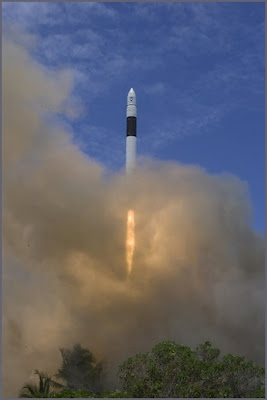 Forgotten in the dread of what's been referred to as The Gap, the downtime at Kennedy Space Center between the 2010 retirement of the thirty year old Space Shuttle and orbital testing of Block One of the Orion CEV in 2015, may be Space Exploration Technologies, or SpaceX, recently awarded a solid launch services contract for its Falcon 1 and Falcon 9 boosters.
Forgotten in the dread of what's been referred to as The Gap, the downtime at Kennedy Space Center between the 2010 retirement of the thirty year old Space Shuttle and orbital testing of Block One of the Orion CEV in 2015, may be Space Exploration Technologies, or SpaceX, recently awarded a solid launch services contract for its Falcon 1 and Falcon 9 boosters.It was yet another sign of NASA's faith in the Hawthorne, California-based company, with its test facilities in Texas and an equatorial launch site in the Marshall Islands, on Kawajalein. SpaceX may not be the only commercial space company in the U.S. or the world, but its serious, steady progress has clearly taken them past the point of being a "start-up."
On tap soon from the methodical SpaceX are the Falcon 9 Heavy and the Dragon ATV, which like the ESA's Jule Verne, mights be adapted to carry seven passengers or a pressurized cargo, docking with the International Space Station. If NASA is allowed to further fund the Commercial Orbital Transportation System, or COTS, there may be no need for any Gap at all.
Last week, NASA awarded SpaceX a NASA Launch Services contract for the Falcon 1 and Falcon 9. The NASA Launch Services contracts are multiple awards to multiple launch service providers. Twice per year, there is an opportunity for existing and emerging domestic launch service providers to submit proposals if their vehicles meet the minimum contract requirements.
The contract is an "Indefinite Delivery/Indefinite Quantity" (IDIQ) contract where NASA may order launch services through June 30, 2010, for launches to occur through December 2012. Under the NASA Launch Services IDIQ contracts the potential total might be anywhere between $20,000 and $1 billion,, depending on the number of missions awarded.
The contract seeks a launch capability for payloads weighing 551 pounds or heavier into a circular orbit of 124 miles at an orbital inclination of 28.5 degrees. Payloads would be launched to support three NASA mission directorates: Science, Space Operations and Exploration Systems.
Because an IDIQ contract has been awarded to SpaceX, it can compete for NASA missions using the Falcon 1 and Falcon 9 launch vehicles as specified by the NASA Launch Services contract process.
NASA's Launch Services Program at Kennedy Space Center is responsible for program management. This award to SpaceX adds to the stable of launch vehicles available to NASA under previously awarded contracts. The original request for proposal was issued in 1999.

No comments:
Post a Comment